Headphone performance and sound quality
To test out the Funk’s speaker-driving abilities I decided to test it out immediately with my KEF LS50’s in my lounge room to see how it fared stacked up to my other ‘full size’ speaker amps. The LS50’s do like quite a bit of juice, and after a few different amp pairings, I had settled on a custom Class D amp to drive them: an NCore500-based design capable of a stonking 400 Watts per channel. Sure, I’m probably only ever using a fraction of those Watts in my place, but headroom is always nice, right? The Funk did need to nudge just past the 1 o’clock range on the volume pot to get to room-filling volume, but it did so superbly. The out-and-out rock-solidness and low-end grip of the NCore500 amp might not have been all there in the Funk, but the Funk had it absolutely licked for tone. The LS50 is a very neutral and revealing speaker and can border on sterility at times – what the Funk made me realise is that there really is no substitute for a good Class AB design when it comes to a tonal match for the LS50’s, and it gave them a much-needed boost in tonal mass, particularly in the mid-range. Let’s just say that my NCore500 amp has been packed away in a box ever since.
It was great to know that the Funk can tango with the KEFs in a moderate sized-room, but it was clear that it would eventually run out of puff if pushed harder in a larger environment. Moving the KEFs onto my desk was a far more appropriate setting for the Funk’s intended purpose, and it absolutely shone in this set-up. The LS50’s imaging capabilities were on full display with them set up on 6 inch stands on each corner of my desktop set-up, leaving about a 10-inch gap from the rear wall to account for their rear bass ports. 35 Watts into 8 ohms s more than you’ll ever need in this setting, and the Funk has the tone technicalities to make for a superb nearfield amp partner with the LS50.
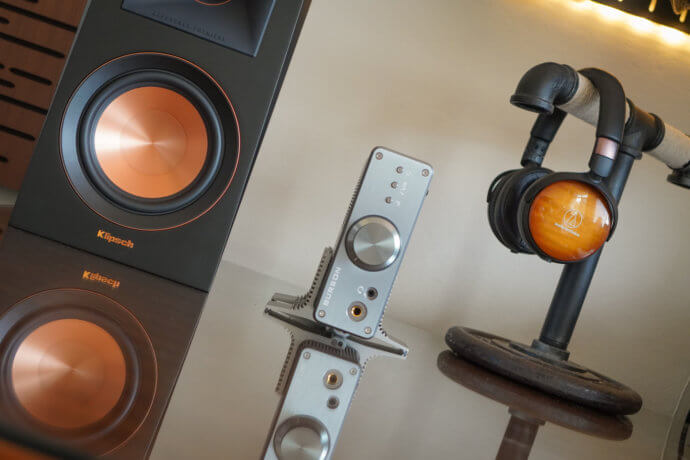
Burson Audio Funk
I’ve had a couple of other bookshelf speakers in my place of late as I’ve been looking for a new nearfield set-up to be driven from moderately-powered amps like the Funk. Up next, I paired it with the RP-500M from Klipsch, the ‘middle’ child of their Reference Premiere bookshelf line of speakers. One reason why I was interested in Klipsch speakers is the fact that they’re generally much more sensitive than comparably-sized bookshelf speakers – the RP-600M has a claimed 93dB rating (although I suspect that it’s slightly less than this). The other thing that drew me towards the RP-500M is a voicing that reminds me a lot of Grado headphones: they’re bright, dynamic and somewhat aggressive, making them a perfect match for rock, and live music in particular. The Funk gets the RP-500Ms singing at just past 10 o’clock in a near-field arrangement, pumping out an authoritative, revealing and visceral (potentially neighbour infuriating) take on Tool’s ‘Pneuma’. The little Klipsch speakers can get slightly brittle depending on amp pairing, but the Funk’s less-than-lean voicing evens out the RP-500M’s tonal characteristics to make a well-balanced match – the Funk with sensitive speakers is an incredible match, and I can only imagine how it might perform with the RP-500M’s bigger brothers such as the 109dB Klipsch La Scala…which I might add, also cost $25K in this part of the world. Still, one can dream…
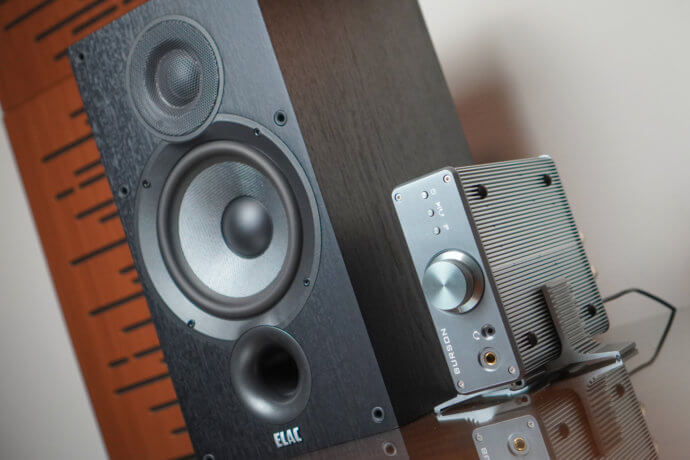
Burson Audio Funk
One of the trickier parts of setting up speakers in a nearfield arrangement is their relationship to the rear wall behind them. This might seem a little unusual to those of you unfamiliar with the ins and outs of speaker behaviour in rooms, but it can affect their perceived low-end performance greatly. In the hunt for the ‘perfect’ nearfield passive bookshelf speaker, I got my hands on a pair of the Elac Debut 2.0 B6.2, the latest revisions of the famed Andrew Jones-designed range from the German speaker manufacturer. The B6.2 is a considerably larger bookshelf than both the KEF and Klipsch speakers and has a nominal impedance of 6-ohms well as a sensitivity rating at 87dB. Despite its sensitivity being markedly lower than the RP-500M, the B6.2 required about the same amount of power from the Funk to achieve a similar sound pressure level. The reason I was curious about the Elacs was the fact that their bass port is front-situated, which makes them less fussy about placement with regards to their distance from the rear wall. Being able to push the B6.2 right to the back of my desk did create some much-needed desktop space, and turned out to be probably my favourite nearfield pairing with the Funk. The B6.2 has a real ‘Goldilocks’ tuning, being hugely transparent (with far more treble detail than their B6 predecessors) while retaining lively dynamics and a well-balanced sound signature top-to-bottom. I think the Elac Debut 2.0 B6.2 + Funk combo will be performing desktop duties around here together for the foreseeable future, it’s a terrific pairing.
Final thoughts
It’s clear that Burson Audio has learned from their experience creating their earlier ‘Fun’ and ‘Bang’ models, and have managed to create a pretty special little device in their new Funk. As well as being both a terrific headphone and nearfield speaker amplifier, it somehow manages to be greater than the sum of its parts – it really does make a solid claim for itself as the only analogue device that deserves a seat at your desktop. I have tried finding a similar style of device to use in the past, and they’re either too large and prohibitively expensive like the Schiit Ragnarok, or have compromised headphone performance, such as the Emotiva BasX A-100 which is only really well suited to super low-sensitivity planars.
You are going to need to BYO source device with the Funk, but the fact that you can mix/match source gear does add to the Funk’s flexibility and does future proof it in that sense. And the Funk does make a solid ‘future proof’ proposition in terms of its performance as it happens to be a terrific-sounding device that pairs well with a wide range of both headphones and speakers. Throw in the fact that it looks great and is a delight to use, and it’s an absolute knock-out device in every regard. Sure, a remote and a couple of extra inputs/outputs would be nice, but at this size and price, it’s hard to complain. The Burson Audio Funk is an unreserved recommendation from us here for those of you looking to get the best out of your headphones and speakers on your desktop.






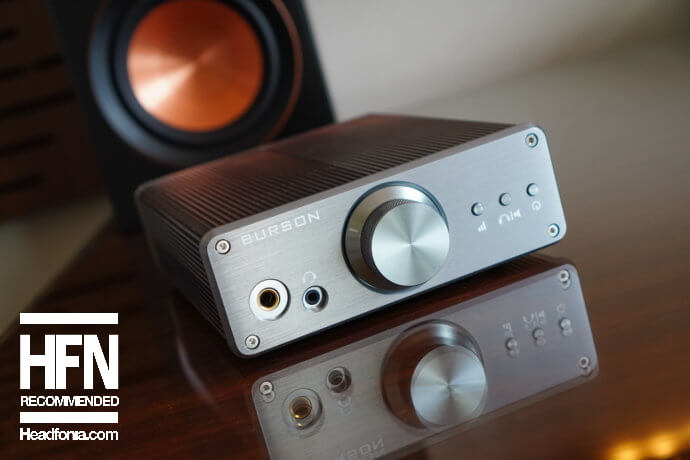
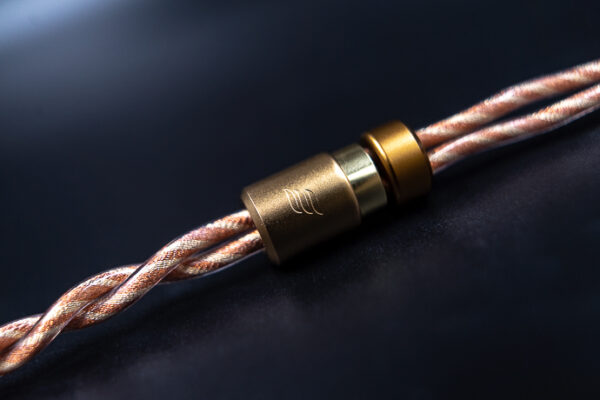
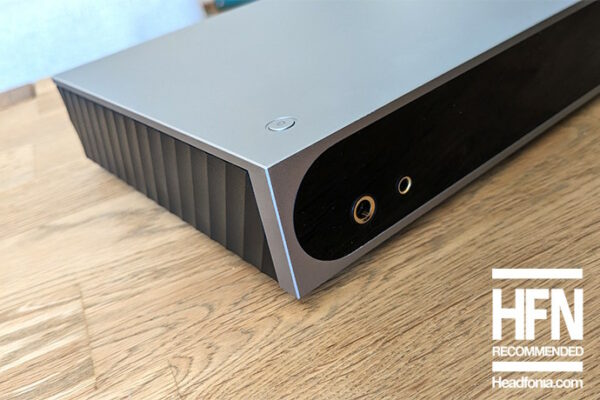
Ivan
Hello Mathy Graham, My name is Ivan,
I need to know how to use the FUNK to My current PC Setup.
I am having a PC as source, and DACmini CX as DAC/AMP combo.
My PC is old, and the onboard output and mic input are terrible.
So I want to add FUNK as my speaker / headset amplifier.
As for the headset, do you think the mic pass through to the PC will bring the mic quality up? (As my motherboard onboard audio is terrible)
Thank you.
Matty Graham
Hi Ivan,
The DACmini should take care of your soundcare problems, if you’re connecting your PC to it via USB/Optical. From there, you would connect the RCA outputs of the DAC to the RCA inputs on the Funk.
I’m not sure about the mic quality however – the Funk is simply a ‘passthrough’. It would be the same as connecting a pair of headphones with an inline mic into the headphone adapter of your PC (if that can recognise a TRRS microphone input).
Best to test with an old pair of smartphone earphones with an inline mic (or your headset) to see if that works?
Ivan
Hi Matty,
So yes i had the DACmini served me well for years, but now i want to accomodate it for my son gamings peripheral too. The FUNK will not improve the mic quality as it just bypass it, so i think i better get the PLAYMATE2 to replace the DACmini.
Thanks for the respond.
Ivan
Hello Matty, i have questions:
“Firstly, the Playmate 2 doesn’t have a dedicated line out mode,
meaning that you’ll need to set the volume to ’99’ (= max), which takes a few cranks of the volume wheel to do so”
Q: When its paired with FUNK, do you mean that the playmate2 volume control also control the lineoutput volume ?
So that there is dual volume control here?
“and if we are getting technical, then you could also splice the pre-output of the Playmate 2 to a subwoofer as well”
Q: But how you are going to pair it with the FUNK, as there is only 1 output?
Thank you
Matty Graham
Yes, you can control the volume with either the Playmate 2 or the Funk. If you’re not using a subwoofer, I’d probably set the Playmate 2 to ’99’ and use the Funk’s pot to control the volume.
You can easily add a subwoofer (or other downstream device) by simply putting RCA splitters into the L/R outputs of the Playmate 2 – I just use these: https://www.jaycar.com.au/rca-plug-to-2-x-rca-socket/p/PA3560?gclid=Cj0KCQjwwY-LBhD6ARIsACvT72PAgTfZOu-s1-hltipgjAbK3yOCTPdKsVb8-rwWK4PGE-2SXJXatPMaAnIYEALw_wcB
BOL
Hi,
Currently trying to decide between the Funk or the Soloist 3x.
I don’t need the extra power as I’ll be using it primarily for IEM’s (Odins), but if the Soloist has better sound quality it would be worth it.
But if they basically sound the same and just have different applications (the Funk can power speakers, the Soloist can power demanding headphones) then the Funk will suit my needs.
Any thoughts?
Matty
Both are overkill for IEMs, you definitely don’t need a soloist. The Funk could be an ok solution if you need to power speakers too, but you’re probably better off with something much lower powered.
BOL
Thanks for the quick reply!
I know it seems like amps for full sized headphones like this is overdoing it, but I (and others) have found the Odins really scale up/are amp picky.
For instance, I’ve listened to the Odins extensively from my iBasso DX160, Gilmore Lite Mk2, and Cayin iHA-6 (and an old Asgard 2). The sound stage is small and congested with the 160 (it’s just ok for portable use), with the Mk2 the sound stage is pushed too forward (not enough depth) but there is more power and control, and with the powerful iHA-6 the sound stage really opens up, control and transients are superb, layering, instrument placement, and depth are much better, and the bass is much more powerful…the problem is there is a hardness/glare/metallicness to the iHA-6 I’ve never liked. (The Asgard I’ve never liked: just kind of a “rough” or “crude” sound to me which definitely drags down better gear like the Odin).
But besides power, what I’m really looking for is sound quality: is the Funk as good (or close to) the Soloist in terms of just the headphone out, or is it less refined, with less of a sound stage, less control, etc. I don’t want another middling mid-tier headphone amp; I want something that sounds excellent (has no significant defect like all my amps above do). But if the single out is essentially the same, then I don’t need the extra power.
It’s also possible, however, that at some point that I will jump into the high tier of headphones and the additional power will be needed or highly beneficial.
I would really like to be satisfied with just a $200 – $500 range amp here, but so far in that range, over many months of listening, I’m not. I’ve even blind tested and came to the same conclusions.
Thanks again for any advice!
BOL
Forgot all about this.
Just to follow up: I ended up ordering the Funk stock and it sounds very good with both my Odin IEMs (silent background too) and my HE1000v2.
The Funk is just on another level in terms of sound signature and technicalities over the Cayin iHA-6. There’s a lot more depth to the sound stage with better imaging (the Cayin is wider, but presents more of a flat wall of sound), the timbre is a lot more realistic (sounds “natural”), there is more impact/slam and weight to the notes, and the highs are natural, refined, and not fatiguing, at least to me, with the Odins and HE1000v2.
I also tested a friends Topping A90, and, to put it honestly, it sounded bad compared to all my other mid tier amps: just a cheap, clinical, cold, unresolving sound signature with edge/etch, glare, hardness, and a haze or gauze over everything. It was like the Cayin iHA-6 overall, only without any of the clarity and good technicalities that amp does have.
So, as I suspected, it’s not so much a matter of power as it is superior sound signature/technicalities and good IEMs and headphones will benefit from that. My next amp will be the Ferrum Oor that I will use with both my Odins and HE1000v2 that I’m sure will take both of them to the “final” level of performance.